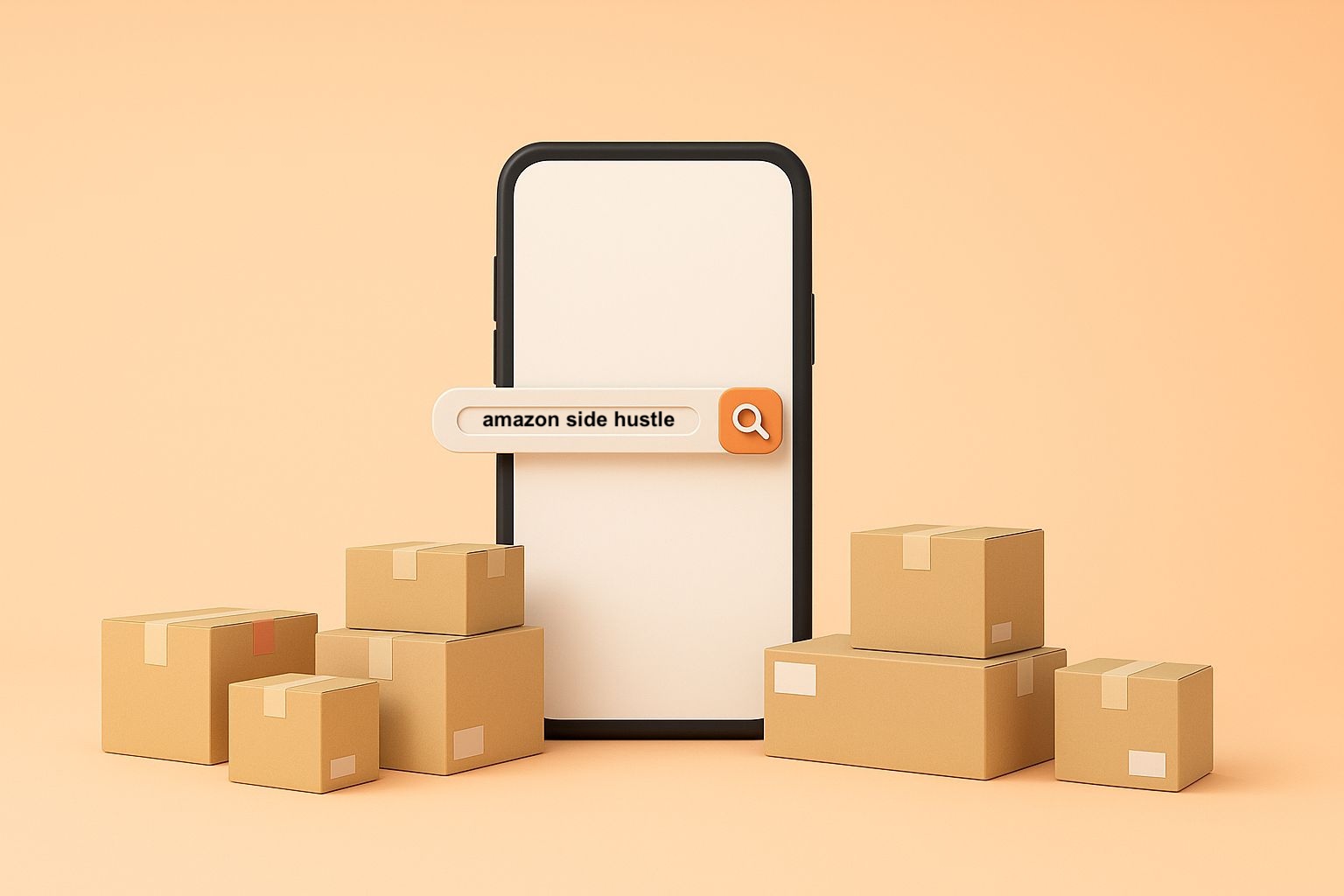Your Improved Amazon Digital Marketing Strategy for 2025

Amazon hosts over nine million sellers on its platform – and counting. Of the new sellers, only 10% survive their first 12 months on Amazon, meaning 90% go bankrupt before their business can even take off.
This may make it seem particularly difficult to enter and stay on the Amazon marketplace, but the truth is – it’s not. Not if you have a solid, multifaceted plan and follow through diligently.
While many sellers start out on Amazon as a side hustle and assume it’s enough to just let things run on autopilot, the ones who actively build and optimize their business are the ones turning a profit at the end of the day. Not really surprising, is it?
Building a business consists of many facets – most of which we discuss across our blog. But in this article, we’ll be discussing why selling on Amazon requires a digital marketing strategy and what factors you should take into account when building yours – especially when it comes to data.
TL;DR: Amazon Digital Marketing in 2025
Why Is Amazon Digital Marketing Crucial for Success?
Keep in mind that Amazon is both a sales channel and a search engine. Buyers use the search engine first before they find your product, which means your processes need to be aligned with what Amazon – as a product search engine – is looking for.
How do you do this? Visibility on Amazon is determined by the A10 algorithm, which means that sales velocity, relevance, and off-Amazon traffic are all elements that will be factored into how well your products are visible on Amazon. Well-curated online marketing can help your products stand out in saturated marketplaces like the U.S. or the EU. The core success metrics remain the same across all marketplaces:
Core Pillars of Your Amazon Digital Marketing Strategy
As we already touched upon earlier, you don’t need to be a marketing genius in order to succeed on Amazon. A grasp of the most elemental marketing techniques is more than enough to help you stand out against most of the competition. Specifically, there are five core pillars in digital marketing for Amazon that will put you far ahead of your competitors, when done correctly.
Product Listing Optimization (Amazon SEO)
Read our article on how a PIM tool can help you win at product listing optimization for Amazon if you want to find out more.
Amazon Advertising (PPC & Beyond)
If you’re wondering: “What is Amazon PPC?” This article has everything you need to succeed.
Brand Building & Storytelling
You’re selling more than just a product? Find out here how to present the perfect Amazon brand story.
External Traffic & Omni-Channel Marketing
Review & Reputation Management
Are you selling FBM and wondering how to deal with negative reviews? Check out these 5 Tips for dealing with them.
Step-by-Step: Building an Amazon Internet Marketing Strategy That Converts
If you want an Amazon digital marketing strategy that drives sustainable growth, you’ll need more than just PPC ads. Build a system that connects your product with the right audience, at the right time, and with the right message.
1. Research & Positioning
Take a closer look at your market. Begin with your top competitors – what are they doing right, where are they going wrong? Use this info to define your unique value proposition (UVP): the reason online-shoppers should choose your product over the competition’s. This will shape everything from your listings to your ad copy.
2. Audience Targeting
In the next step, find out who your ideal customer persona is. It’s important at this stage to go beyond basic demographics – so dig as far as you can into your demographic’s shopping habits, search intent, and what motivates them to buy. This helps you creat product pages and ads that address your buyers’ needs directly.
Example:
Let’s say you’re selling reusable water bottles. Instead of targeting “men and women aged 18 – 45,”:Once you know this, tailor your messaging – highlight eco-friendly materials for one group and durability for the other – so your listings and ads speak to what matters most and drive more conversions.
3. Keyword & Listing Optimization
Amazon marketing means connecting your products and your customers. Keywords do just that. Research high-performing search queries on tools like Google Trends (free) or Semrush (paid) and map them strategically to your listings and ad campaigns. Additionally, don’t forget to ensure that your titles, bullet points, and descriptions are optimized for search visibility and conversion.
4. Launch & Advertising Setup
When you launch a product or try to improve the sales of an existing one, adjust your PPC campaigns to your company growth stage. Start with automatic campaigns to gather data, then refine with manual targeting to increase your ROI. Keep testing different ad types – Sponsored Products, Sponsored Brands, and Sponsored Display – to find what drives the best results.

5. Content & Branding
Visuals and brand story will make or break your sales in e-commerce, as they are the substitute for testing and touching the object, which is possible in brick-and-mortar stores. In order to improve Use A+ Content and a branded Amazon Storefront to showcase your products professionally. Consistency across all listings builds trust and strengthens your brand identity.
6. Off-Amazon Promotion
Don’t rely solely on Amazon traffic. Use your marketing on Amazon to drive external traffic through social media, email campaigns, and influencer collaborations. Off-Amazon promotion not only boosts visibility but can also improve your organic ranking within Amazon.
7. Track, Analyze, and Scale
Finally, monitor your performance closely. Keep an eye on key metrics such as click-through rate (CTR), conversion rate, and advertising cost of sales (ACoS). Use these insights to optimize your strategy, scale what works, and cut what doesn’t.
Advanced Tactics for U.S. Sellers
Once the basics are covered – strong listings, good PPC campaigns, positive reviews – it’s time to move beyond this and tackle the challenges (and opportunities) for which the U.S. Amazon marketplace is known for.
Use Amazon DSP for Retargeting and Brand Growth
Amazon DSP (Demand-Side Platform) gives you access to programmatic display and video ads both on and off Amazon. As opposed to Sponsored Products or Brands, DSP enables you to target audiences based on where they browse and what they purchase.
With Amazon DSP, you can reach shoppers who scrolled by your products without buying, or even those who viewed competing listings. This makes it easier to re-engage these shoppers who are already familiar with your product but maybe just need a second nudge.
Use Data and AI Tools to Refine Your Strategy
Good analytics tools can spot patterns in ad performance or listing optimization faster than manual tracking ever could (and they make no mistakes either). This convenience allows you to make data review part of your weekly routine, not a monthly afterthought. It also saves you the money of hiring an extra data analyst – funds that you can allocate to more impactful areas.
With SELLERLOGIC Business Analytics, you can easily track which products are selling fast and which ones need attention, allowing you to make data-driven inventory decisions. This insight also supports your marketing strategy by showing where to allocate your budget – so you can focus on the products that deserve the most push.
Video Marketing
Video content is one of the best marketing converters for Amazon. Sponsored Brand Video Ads grab attention in search results, while short lifestyle clips on listings help shoppers visualize the product in use.
If your brand isn’t yet using video, start small: one clean, 15–30 second clip showing your product’s key benefits can outperform static images immensely.
Plan Around Seasonality
U.S. sellers have more peak shopping events than anyone else – Prime Day, Back-to-School, Black Friday, Cyber Monday, and even category-specific holidays like “Pet Day” or “National Coffee Day.”
Prepare early: ramp up ad spend and inventory weeks in advance, update creatives for seasonality, and build campaigns that capture attention before competitors flood the market.
Think Omnichannel
Need your Amazon account to have an extra edge as opposed to your competitors? Imagine potential buyers seeing your competitors only on Amazon, but your brand everywhere. External channels are extremely helpful when it comes to branding. Sync your efforts with your DTC site, email marketing, and social channels for omnipresent branding and messaging.
When you drive traffic from Google, TikTok, or Instagram to Amazon listings (using Amazon Attribution), you’re not just increasing visibility – you’re feeding Amazon’s algorithm with external traffic signals that will boost organic ranking as well. Win-win all the way.
What Common Mistakes You Can Avoid Easily
Even experienced sellers fall into traps that quietly kill performance. Avoiding these can save you thousands in wasted ad spend and lost visibility.
1. Keyword Stuffing and Poor Listing Quality
Amazon’s A10 algorithm works very close to the customer, which means that it rewards relevance, not repetition. Stuffing keywords into your title or bullets makes your copy unreadable and will hurt your conversions. Instead, focus on shopper-friendly language and natural integration of keywords.
2. Ignoring Reviews and Customer Feedback
Failing to monitor and respond to reviews will make you miss valuable insights into what’s working and what’s not. Actively manage feedback, resolve issues quickly, and encourage satisfied customers to share their experience.
3. Unstructured Ad Campaigns
Launching multiple campaigns without clear segmentation is like throwing money into the void. Group your ads by match type or product line, set specific goals for each campaign, and monitor performance closely.
4. Neglecting External Traffic
Many sellers focus solely on Amazon PPC and forget that Amazon rewards listings that attract outside visitors. Use social ads, influencer collaborations, or content marketing to drive traffic from beyond the platform.

Final Thoughts
The days when you could loosely research products on Alibaba, source and list them with keyword-stuffed descriptions and titles, and hope for the best are long gone. In 2025 and beyond, Amazon and marketing go hand in hand, meaning there’s no way to sell successfully on Amazon while neglecting digital marketing in your business plan.
Winning on Amazon today means winning on both sides of the equation: the algorithm and the audience. You need to know which algorithmic boxes to tick, but also what makes your customers click. Luckily, the new A10 algorithm rewards exactly that – customer-friendly listings – so make sure your digital marketing strategy on Amazon is aligned with it.
FAQs
Amazon digital marketing is the combination of strategies that help you make your products more visible and appealing to shoppers on and off Amazon. It includes listing optimization (SEO), advertising (PPC, DSP), brand storytelling, external traffic campaigns (social media, influencer marketing), and review management – all aimed at driving sales and improving your organic ranking.
Because competition on Amazon is fierce – with over 9 million sellers, simply listing your product isn’t enough. A strong digital marketing strategy ensures your products are seen by the right audience, your ads are optimized for profitability, and your brand stands out. Without it, you risk being invisible in Amazon’s search results, no matter how good your product is.
Some of the most effective tools for Amazon sellers include:
– SELLERLOGIC Business Analytics – for data-driven product and inventory insights.
– Google Trends – for keyword research, listing optimization, and competitive analysis.
– Amazon Brand Analytics – for understanding search terms and customer behavior.
– Amazon Attribution – to track the impact of off-Amazon traffic (Google, TikTok, Meta).
Using these together helps refine your strategy, lower your ACoS, and boost your organic growth.






